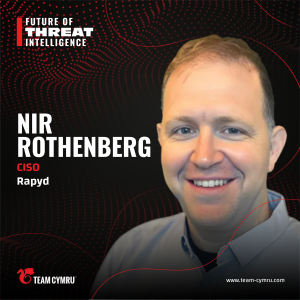
Thursday Apr 24, 2025
Rapyd’s Nir Rothenberg on Breaking the CISO Burnout Cycle Through Focused Priorities
From cleaning up after an insider theft of the notorious Pegasus spyware to safeguarding billions in payment transactions, Nir Rothenberg brings battlefield-tested security leadership to his role as CISO/CIO at Rapyd, and joins David on this episode of The Future of Threat Intelligence to share all his lessons learned.
In this no-holds-barred conversation , Nir delivers a wake-up call to security leaders still pretending they can defend against everything, offering instead a radical prioritization framework shaped by watching elite hackers routinely break supposedly "unbreakable" systems.
Nir challenges conventional CISO thinking by ruthlessly eliminating theoretical threats from his roadmap, explaining why even Google-level security can't ultimately stop determined nation-state attackers, and providing practical strategies for focusing resources exclusively on threats that organizations can realistically defend against.
Topics discussed:
- The challenges of prioritizing security efforts based on attacker capability tiers, focusing resources on threats that can realistically be defended against rather than top-tier nation-state actors.
- How working with elite offensive security teams fundamentally transforms a defender's understanding of what's feasible in attack scenarios and reshapes security investment decisions.
- The evolution of breach disclosure practices and why current placative approaches prioritize shareholder confidence over sharing actionable details that would help other defenders.
- Strategic approaches to developing security capabilities through partnerships rather than building in-house, particularly for specialized functions like threat intelligence.
- Why even major crypto breaches often stem from preventable issues like social engineering rather than sophisticated technical exploits, and how to prioritize defenses accordingly.
- Practical strategies for combating CISO burnout through focused prioritization and avoiding the tendency of boiling the ocean that leads to ineffective security programs.
- Creating collaborative security ecosystems that leverage the numerical advantage defenders have over attackers when working together effectively.
- How to extract meaningful intelligence from breaches beyond just indicators of compromise, focusing on understanding attacker methodologies and misconfigurations that can be tested and remediated.
Key Takeaways:
- Prioritize security resources based on attacker capability tiers, focusing efforts on threats that can realistically be defended against rather than top-tier nation-state actors that will find a way in regardless of defenses.
- Implement a strategic partnership approach with specialized security vendors instead of building capabilities like threat intelligence in-house, leveraging their decades of experience to enhance your security posture more efficiently.
- Demand more detailed technical information in breach disclosures from vendors and partners, seeking specific misconfigurations and vulnerabilities that were exploited rather than just indicators of compromise.
- Position your security leadership role within the management team to enable greater impact, reducing bureaucratic barriers to implementing innovative security controls and technologies.
- Evaluate emerging security startups as design partners before they become widely known, creating a competitive advantage through early access to cutting-edge security capabilities.
- Challenge theoretical security risks like AI data exposure by comparing them with documented threats that have caused actual damage, allocating resources proportionally to proven rather than hypothetical dangers.
- Leverage M&A transitions as opportunities to eliminate technical debt and modernize security practices rather than just viewing them as risk events requiring assessment.
- Adopt comprehensive breach intelligence sources like the Verizon Breach Report to compensate for the limited technical detail in most public breach disclosures.
- Combat CISO burnout by focusing exclusively on security elements you can control and impact.
- Create collaborative security ecosystems with partners, vendors, and internal teams to maximize the numerical advantage defenders have over attackers when working together effectively.
No comments yet. Be the first to say something!